Light cruisers like "Svetlana". Part of 3. Firepower versus peers
Artillery
It is well known that the Svetlana was supposed to get 15-mm / 130-armament 55 with 1913 armaments. At that, ten guns were located on the upper deck of the ship, three guns on a forecastle and two on the aft superstructure. The location of the artillery should have allowed a very strong fire to be concentrated on the bow and stern of the ship, but then questions immediately arise.
The fact is that the guns on the Svetlana were placed in the majority of the port, in deck shield installations and casemates: in theory, they were shooting directly at the rate of nine guns, and at the stern - of six. As a rule, the installation of guns in this way still did not allow to fire directly on the nose (stern), because gases escaping from the barrel during a shot damaged the sides and superstructures. This seems to be confirmed by A. Chernyshev, who writes in his monograph, with reference to the 1913 g specification, that only a tank gun could shoot at the nose, and only two guns on the stern superstructure could shoot at the stern. The remaining guns placed in deck installations and casemates on the sides of the cruiser, could not shoot straight along the course, but only at 85 degrees from the beam (that is, at an angle of at least 5 degrees to the ship's course).
Unfortunately, the author does not have the specification that A. Chernyshev refers to, but there is a similar “Specification of the light cruiser for the Black Sea“ Admiral Lazarev ”built by the Society of Nikolaev factories and shipyards. For booking and artillery. ”, And it says quite differently.
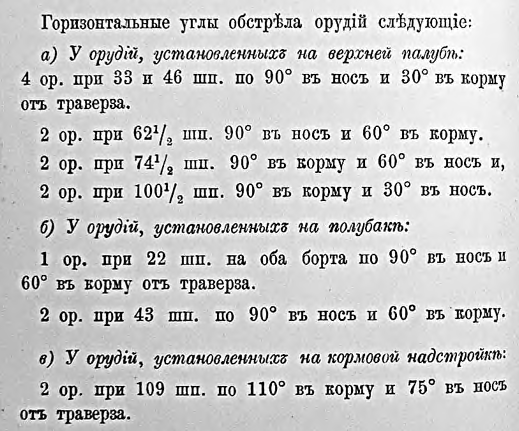
And if the artillery of the Black Sea cruisers still had the task of firing directly along the course, then why wasn’t such a task set for the Baltic cruisers? This is extremely doubtful, and in addition, in the description of the hull construction, A. Chernyshev himself gives information about special reinforcements and thickening of the “have blown guns” plating. And therefore there is every reason to assume that when designing cruisers of the Svetlana type, fire right on the bow or stern was originally intended.
On the other hand, to set a task is one thing, but to achieve its solution is quite another, so one can only guess whether the Svetlana could actually develop such a strong fire on the bow and on the stern or not. But even if they could not, then you still have to admit that cruisers of this type had extremely powerful fire on sharp bow and stern corners.
The fact is that the light cruiser very rarely has to catch up or retreat, having the enemy strictly on the nose (stern). This is explained by the fact that in order to catch up with the enemy, it is necessary not to go straight at him, but to move along a course parallel to him, as illustrated by the diagram below.
Suppose two ships (black and red) were going towards each other before mutual detection (solid line), then black, seeing the enemy, turned and lay down on the opposite course (dotted line). In this case, the red ship to catch up with black, it makes no sense to try to go straight at him (dash), and should lie on a parallel course and catch up with the enemy (dotted line). And since the "work" of light cruisers is connected with the need to catch up with someone (or run away from someone), the ability to concentrate fire on sharp bow and stern angles is very important for him, perhaps more important than the number of trunks in side salvo. This is often forgotten, comparing only the mass of onboard volleys and evaluating the placement of the guns only in terms of maximizing the fire on board. Such an approach might be right for a battleship, but a light cruiser is not a battleship and is not designed to fight in line. But when leading destroyers, when performing reconnaissance functions, catching up with enemy ships or fleeing from them, it is more important for a light cruiser to have a strong fire on sharp bow and stern corners. That is why (and not at all due to the natural lack of mind of designers) we can regularly see on the First World War light cruisers a pair of guns in the bow or stern, arranged according to the Varyag cruiser method.
With regard to the battle on the sharp corners of the cruiser type "Svetlana" were very strong. So, on a target located in 5 degrees from the ship's heading, five 130-mm / 55 guns could fire on the nose, and four in the stern. The target, which is on the course angle 30 on the bow or stern, came under fire from eight guns.
As we have said, at the time of the laying of the Svetlan, the British built two types of light cruisers: scout cruisers for squadron service, reconnaissance and destroyer lead, and trade cruisers, the so-called “towns” (named after English cities). The same age scout for “Svetlan” were the cruisers of the Caroline type, the first cruisers of the so-called “C” type and the last “cities” - the cruisers of the “Chatham” type of the Birkenhead subtype, which some researchers call the best light cruisers in England of wartime.
Of the listed cruisers, the Caroline was the smallest and carried the weakest weapons - the 2-152-mm and the 8-102-mm, and the layout of the artillery was very original: the main thing weapon the cruisers, both 152-mm guns, were located in the stern in a linearly elevated pattern, six 102-mm guns were stationed on the board and two on the ship's tank.
I must say that the placement of the main caliber "in the rear" contradicted all the traditions of British shipbuilding. But the British believed that fights with light cruisers would be fought out, and 102-mm guns would be better suited to attack the destroyers, and that was quite reasonable. Nevertheless, Caroline is expected to lose to Svetlana in absolutely everything - theoretically 4 102-mm guns against 9 130-mm can work in the nose, and 2 152-mm and 2 102-mm in stern - against 6 130-mm. On the sharp nasal heading angles, the British cruiser would have fought with three, hardly four 102-mm guns against 5 130-mm, aft - 2 152-mm and 1 102-mm against 5 130-mm in the Russian cruiser. The British have 2 152-mm and 4 102-mm guns against 8 130-mm Svetlana guns in the side salvo. The weight of the onboard salvo at “Caroline” is 151,52 kg versus 294,88 kg “Svetlana”, that is, the Russian cruiser surpasses the “Caroline” by 1,95 times by this indicator. The mass of explosive in one side salvo from the Svetlana is 37,68 kg, the Caroline has only 15,28 kg, here the superiority of the Russian ship artillery is even more noticeable - in 2,47 times.
The light cruiser “Chester” had more powerful artillery, which was located much more traditional than on the “Caroline” - one 140-mm each on the tank and the canteens, and eight 140-mm along the sides. This theoretically allowed to fire directly on the nose and the stern of the three guns, on sharp course aft or bow angles - from two, maximum three, but it gave a very decent side salvo of seven 140-mm guns. The weight of the onboard volley "Chester" was almost equal to "Svetlana", 260,4 kg versus 294,88 kg., But due to the relatively low explosives content in the shells, it lost much of its mass in the side salvo - 16,8 kg versus 37,68 kg., Or in 2,24 times.
Interestingly, in terms of the mass of explosives in the onboard salvo, the much larger Chester almost did not outperform the Caroline with its 15,28 kg.
It is quite another thing - the cruiser "Danae" with its seven 152-mm guns.
On this ship, the pursuit and return guns were placed in a linearly elevated pattern, and the other two were not airborne, but in the middle of the hull, with the result that all six six-inch guns took part in the side salvo from the six six-inch guns. This gave almost equal to the "Svetlana" mass parameters of the side volley (271,8 kg) and explosives in the side salvo (36 kg), but ... at what price? Only two guns could fire on the sharp bow and stern corners of the British cruiser.
As for the German "Koenigsberg", the Germans tried to provide this project not only with an onboard volley of maximum power, but also with powerful fire at sharp course angles.
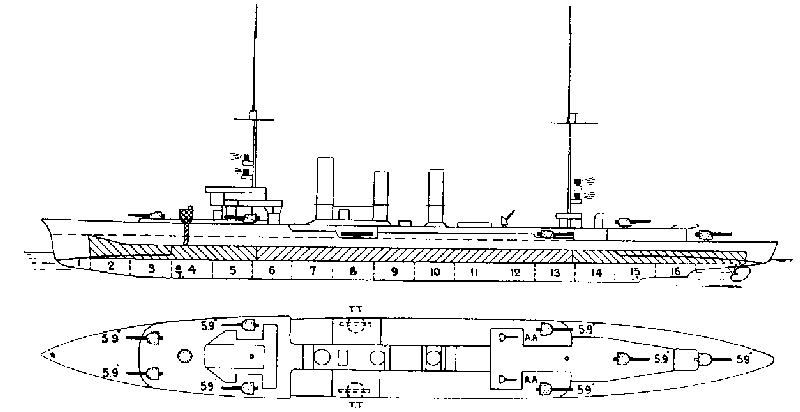
As a result, having a total of 8 150-mm cannons, theoretically right at the bow and stern, the Koenigsberg could shoot four guns, on sharp bow and stern corners - three, and in a side salvo - five. Accordingly, the German cruisers had an impressive mass of onboard volley in 226,5 kg, but still inferior to Svetlana by 1,3 times and the not so impressive mass of explosives in the onboard salvo 20 kg (approximately, as the exact mass of explosives in German 150-mm shells he does not know). By this parameter (approximately) “Konigsberg” was inferior to “Svetlana” by 1,88 times.
The most catastrophic was the backlog of the Austro-Hungarian cruiser "Admiral Spoon". With only seven 100-mm guns, the latter could lead 4 and 3 guns to the bow and stern, respectively, on the acute nasal corners - 3 guns, stern - 2, and in the side salvo - only four. The mass of the onboard volley was some 55 kg.
In general, it can be stated that the domestic "Svetlana" in its artillery weapons was significantly superior to the best cruisers of Great Britain and Germany, not to mention Austria-Hungary. At least as much as equal to the “Svetlana” can be considered unless the cruisers of the “Danae” type, but they, laid down in 1916 g, actually entered already after the war. In addition, the approximate equality in the onboard salvo from the “Danae” was “bought” due to the very dubious refusal of any strong fire on sharp bow and stern corners, where two six-inch Englishmen with their mass of salvo in 90,6 kg and explosives content in The 12 kg salvo was completely lost against the background of five 130-mm Russian guns with their mass of 184,3 kg salvo and the mass of explosives in the 23,55 kg salvo.
Here the reader may be interested in, why the comparison of fire performance, i.e. masses of shells fired over a certain period of time? Is there a trick here? In fact, the author does not consider this indicator as significant and here is why: in order to compare fire performance, you need to have an idea of the firing rate of the guns, that is, their rate of fire, taking into account the actual time of their loading and, most importantly, making adjustments to aim. But usually reference books contain only maximum values of firing rate, possible only under certain ideally-polygon conditions - in a battle at such a speed, ships cannot shoot. Nevertheless, we will make a calculation of fire performance, focusing on the maximum rate of fire:
1) “Svetlana”: 2 kg of shells and 359,04 kg of explosives per minute
2) “Danae”: 1 kg of shells and 902,6 kg of explosives per minute
3) “Konigsberg”: 1 kg of shells and 585,5 kg of explosives per minute
4) “Caroline”: 1 kg of shells and 547,04 kg of explosives per minute
“Chester” stands apart - the fact is that for its 140-mm guns, the BL Mark I with its shells weighing a little more than domestic 130-mm and cartwheel loading indicates a completely unrealistic rate of fire of 12 rpm. If this were the case, then Chester would have won the Svetlana (3 124,8 kg) by the mass of shells fired per minute, but it was still inferior by the mass of explosives produced per minute (201,6 kg).
It should be remembered that for 152-mm guns, reference books indicate the rate of fire of 5-7 rpm, for 130-mm - 5-8 rpm, and only for 102-mm artillery with its unitary loading - 12-15 rds / min In other words, the Chester clearly did not have a rate of fire in 12 rds / min. 12-mm guns of the British of the Second World War, which had characteristics similar to 133-mm guns (140 kg projectile, split charging) and installed in much more advanced tower installations for linkor, had similar “passport” rate of fire (36 rds / min). "King George V" and light cruisers "Dido". But in practice, and they did no more than 7-9 shots. / min
OMS
Of course, the description of the capabilities of the artillery light cruisers will be incomplete without mentioning their fire control systems (FCS). Unfortunately, there are very few Russian-language literature devoted to the fire control systems of the First World War epoch, the information in it is rather stingy, and besides, there are certain doubts about their authenticity, since the descriptions are often contradictory. All this is complicated by the fact that the author of this article is not an artilleryman, and therefore all of the following may contain mistakes and should be interpreted as an opinion, and not as a ultimate truth. And one more note - the description offered to your attention is rather difficult for perception and to those readers who do not wish to delve into the specifics of the OMS, here the author strongly recommends to go straight to the last paragraph of the article.
Why do we need an MSA? It must provide centralized fire control and supply the gun calculations with necessary and sufficient information to defeat the designated targets. To do this, in addition to specifying what ammunition to use and the transfer of commands to open fire, the OMS must calculate and bring to the gunners the angles of the horizontal and vertical guidance of the guns.
But in order to correctly calculate these angles, it is necessary not only to determine the current position of the enemy ship in space relative to our ship, but also to be able to calculate the position of the enemy ship in the future. The data from the range finders is always late, since the moment of measuring the distance to the enemy always occurs before the range finder reports on the measured distance. It still takes time to calculate the scope and give the appropriate instructions to the calculations of the guns, the calculations also need time to set this sight and prepare for the volley, and the shells, alas, do not hit the target all at once with a shot - their flight time for several miles is 15-25 seconds, maybe more. Therefore, naval gunners almost never shoot at an enemy ship - they shoot at the place where the enemy ship will be at the time of the fall of the shells.
In order to be able to predict the location of an enemy ship, you need to know a lot, including:
1) Distance and bearing to the enemy ship at the current time.
2) Courses and speeds of your ship and the target ship.
3) The amount of change in distance (VIR) to the enemy and the amount of change in bearing (VIP) towards him.
For example, we know that the distance between our ship and the target is reduced by 5 cables per minute, and the bearing decreases at a speed of half a degree for that minute, and now the enemy is in 70 cables from us at the course angle 20 degrees. Consequently, in a minute the enemy will be from us in 65 cables for 19,5 bearing hail. Suppose, just in time for this we will be ready to shoot. Knowing the course and speed of the enemy, as well as the time of flight of shells to him, it is not so difficult to calculate the point at which the enemy will be at the time of the fall of the shells.
Of course, in addition to being able to determine the position of the enemy at any time, one must also have an idea about the trajectory of its own shells, which is influenced by many factors - shooting of barrels, gunpowder temperature, wind speed and direction ... The more parameters the FCS takes into account, the greater the chances that we will give the correct corrections and the shells fired by us will fly precisely to the point of the future location of the enemy ship, calculated by us, and not somewhere to the side, closer or farther.
Before the Russian-Japanese war, it was assumed that the fleets would fight on the 7-15 cable, and to shoot at such distances, complex calculations were not needed. Therefore, the most advanced MSAs of those years didn’t count anything at all, but were transmission mechanisms — the senior gunner set the distance and other data on the instruments in the conning tower, and the gunners saw the “installations” of the starrart on special dials, determined the sight and made the gun themselves . In addition, the explorer could indicate the type of ammunition, give the command to open fire, go on a quick fire and stop it.
But it turned out that the battle can be waged at a far greater distance - 35-45 KBT and further, and here the centralized fire control turned out to be too complicated, as it required a lot of calculations, which were performed, in fact, by hand. It took mechanisms capable of producing at least part of the calculations for the senior gunner, and at the beginning of the century similar instruments were created: let's start with the English fire control devices.
Probably the first (at least - among the common) was the calculator Dumaresca. This is an analog computer (AVM, strictly speaking, all the calculating mechanisms in that period were analog) into which you had to manually enter data on the courses and speeds of your ship and the target ship, bearing to the target ship, and based on this data it was able calculate the value of VIR and VIP. This was a great help, but it did not solve even half of the problems faced by the artillerymen. At about 1904 g, another simple, but ingenious instrument appeared, called the Vickers dial. It was a dial on which the distance was displayed, and to which a motor was attached. He worked like this - when entering the initial distance and setting the VIR value, the motor started to rotate with the corresponding VIR speed, and thus the senior artilleryman could at any time see the current distance to the enemy target ship.
Of course, all this was not yet a full-fledged OMS, because it automated only part of the calculations: the artilleryman still had to count the same angles of vertical and horizontal guidance. In addition, both of the above devices were completely useless if the distance change between opponents was not constant (for example, in the first minute - 5 kbt, in the second - 6, in the third - 8, etc.), and this happened at sea all the time.
And, finally, much later, the so-called “Dreyer table” was created - the first British full-fledged fire control system.
The Dreyer table was extremely (for those times) automated - it was necessary to manually enter the course and speed of the enemy ship, but the range finder was directly entered by the range finder, that is, the senior gunner did not need to be distracted by this. But the course and speed of its own ship fell into the table of Dreyer automatically, because it was connected to a gyrocompass and speedometer. An amendment to the wind was automatically considered; the original data came directly from the anemometer and wind vane. The Dumaresk calculator was an integral part of the Dreyer table, but now the VIR and VIP were not just calculated at some point, but they were constantly monitored and predicted for the necessary time for the artillerymen. The angles of vertical and horizontal pickup are also automatically calculated.
It is interesting that in addition to Dreyer (and the table was named after his creator), another Englishman, Pollen, was engaged in the development of the OMS, and, according to some reports, his brainchild ensured much greater accuracy. But Pollan’s OMS was significantly more complex and, importantly, Dreyer was an officer fleet with an impeccable reputation, and Pollen - just obscure civilians. As a result, the Royal Navy adopted the Dreyer table.
So, among the British light cruisers of the first world table, Dreyer received only cruisers of the “Danae” type. The rest, including “Carolyn” and “Chester”, at best, had only Dumaresc calculators with Vickers dials, and perhaps this was not the case.
The Russian cruisers installed artillery fire control devices from the company Geisler and K of the 1910 model. Generally speaking, this MSA was designed for battleships, but it turned out to be very compact, as a result of which it was installed not only on cruisers, but even on the destroyers of the Russian fleet. The system worked as follows.
The distance finder, measuring the distance, set the corresponding value on a special device, the receiving device was located in the conning tower. The course and speed of the enemy ship was determined from observations, its own - on the basis of instruments that were not part of the MSA and were not connected to it. VIR and VIP were calculated manually, and entered into the device for transmitting the height of the sight, and he independently determined the required elevation angles for the guns and transferred them to the calculations.
At the same time, as they say, with one click of the lever, corrections were established for the firing of guns, the wind, the temperature of gunpowder, and later, when calculating the sight, the OSS Geisler constantly took into account these amendments.
That is, if we assume that the British light cruisers of the Chester and Caroline types still equipped with the Dyumaresk calculator and the Vickers dial, then in this case the VIR and the VIP were calculated on them automatically. But the calculation of the sight had to be done manually, and each time adjusting the calculation for numerous corrections, and then manually transfer the sight to the calculations of the guns. A "Geysler" arr. 1910 r manually needed to count the VIR and VIP, but after that the system automatically and constantly showed the correct sight to the gun calculations, taking into account numerous amendments.
Thus, it can be assumed that the MSA installed on the Svetlana was superior to devices of similar purpose on light cruisers of the Chester and Caroline types, but inferior to those on the Danai. As for the German SLA, very little is known about them, but the Germans themselves believed that their instruments were worse than those of the British. Therefore, it can be assumed that the Königsberg OMS did not exceed, and perhaps it was, inferior to that on Svetlana.
Продолжение следует ...
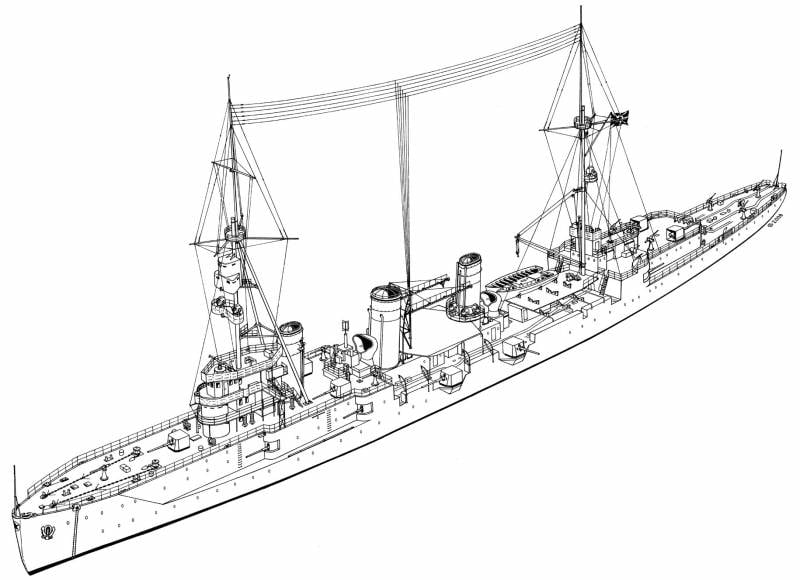
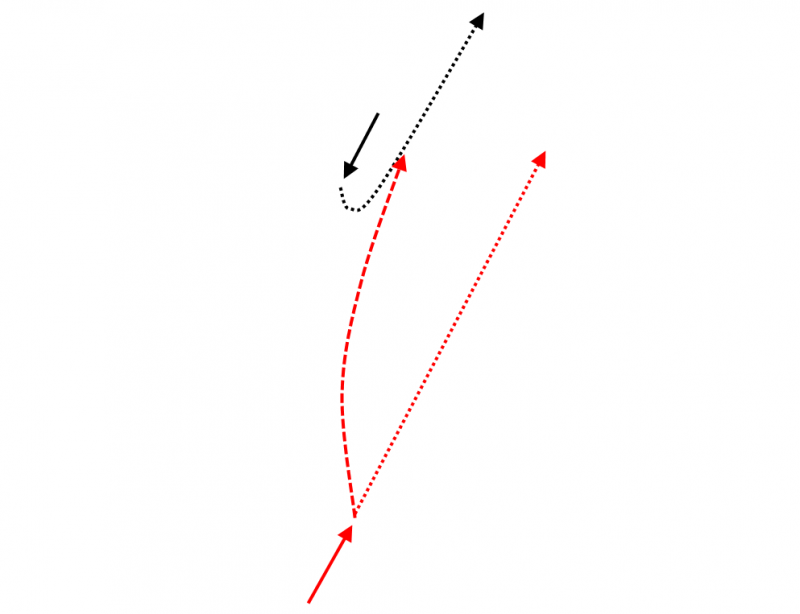
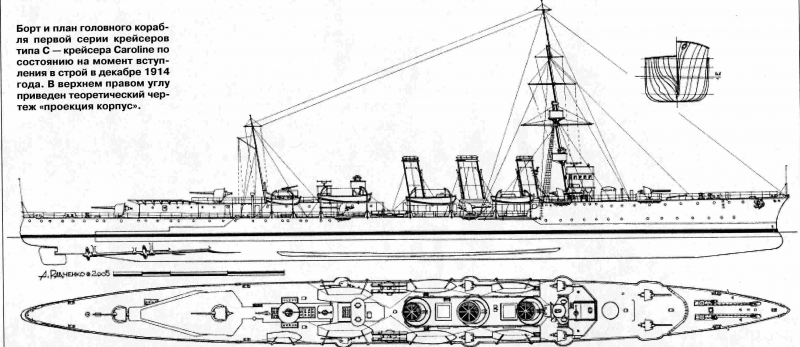
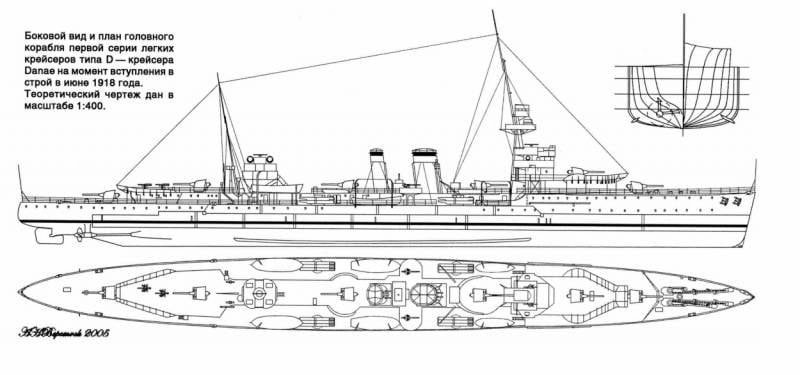
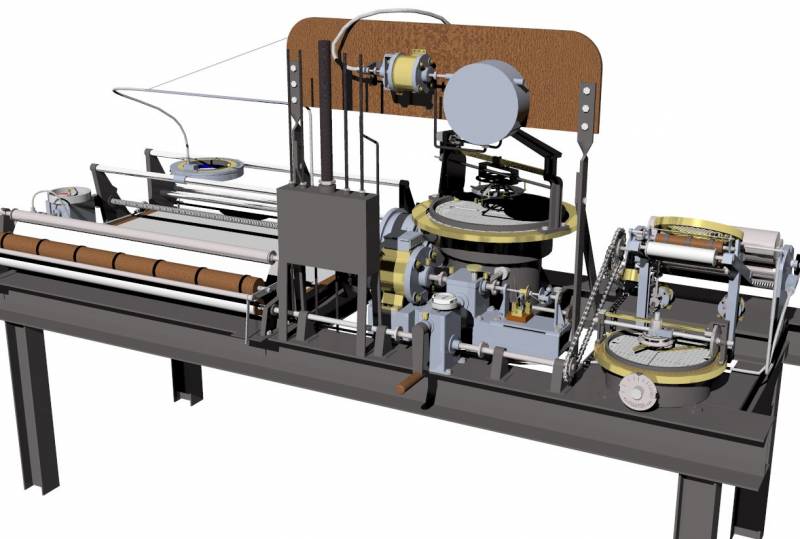
Information